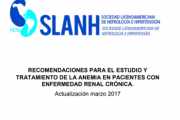 Renal Morphology, Clinical Findings, and Progression Rate in Mesoamerican Nephropathy
Renal Morphology, Clinical Findings, and Progression Rate in Mesoamerican Nephropathy
Julia Wijkstro¨m, MD,1 Marvin Gonza´lez-Quiroz, MD, MSc,2,3 Mario Hernandez, MD,4 Zulma Trujillo, MD,5 Kjell Hultenby, PhD,6 Anneli Ring, BS,7 Magnus So¨derberg, MD, PhD,7,8 Aurora Arago´n, MD, PhD,2 Carl-Gustaf Elinder, MD, PhD,1 and Annika Wernerson, MD, PhD1,7
Background: Mesoamerican nephropathy (MeN) is a chronic kidney disease affecting rural inhabitants in Central America. We have previously described the renal morphology in 8 patients from El Salvador. To confirm the renal pathology, we have studied kidney biopsies from patients with MeN in Nicaragua. Follow-up urine and blood samples from both biopsy studies were collected to investigate the natural history.
Study Design: Case series. Settings & Participants: In the kidney biopsy study, 19 male sugarcane workers in Nicaragua with suspected MeN were investigated with questionnaires, kidney biopsies, and blood and urine analysis. Inclusion criteria were age 20 to 65 years and plasma creatinine level of 1.13 to 2.49 mg/dL or estimated glomerular filtration rate (eGFR) of 30 to 80 mL/min/1.73 m2 . Exclusion criteria were proteinuria with protein excretion . 3 g/24 h, uncontrolled hypertension, diabetes mellitus, or other known kidney disease. In the follow upstudy, blood and urine from the kidney biopsy study in Nicaragua (n 5 18) and our previous biopsy study of MeN cases in El Salvador (n 5 7) were collected 1 to 1.5 and 2 to 2.5 years after biopsy, respectively.
Outcomes: Renal morphology, clinical, and biochemical characteristics, change in eGFR per year. Measurements: eGFR was calculated using the CKD-EPI creatinine (eGFRcr), cystatin C (eGFRcys), and creatinine-cystatin C (eGFRcr-cys) equations. Results: In the kidney biopsy study, participants had a mean eGFRcr of 57 (range, 33-96) mL/min/1.73 m2 . 47% had low plasma sodium and 21% had low plasma potassium levels. 16 kidney biopsies were representative and showed glomerulosclerosis (mean, 38%), glomerular hypertrophy, and signs of chronic glomerular ischemia. Mild to moderate tubulointerstitial damage and mostly mild vascular changes were seen. In the follow up-study, median duration of follow-up was 13 (range, 13-27) months. Mean change in eGFRcr was 24.4 6 8.4 (range, 227.7 to 10.2) mL/min/1.73 m2 per year. Most patients had stopped working with sugarcane cultivation. Limitations: 3 biopsy specimens had 4 or fewer glomeruli.
Conclusions: This study confirms the renal morphology of MeN: chronic glomerular and tubulointerstitial damage with glomerulosclerosis and chronic glomerular ischemia. Follow-up data show that eGFRs, on average, deteriorated. Am J Kidney Dis. 69(5):626-636. ª 2016 The Authors. Published by Elsevier Inc. on behalf of the National Kidney Foundation, Inc. This is an open access article under the CC BY-NC-ND license (http:// creativecommons.org/licenses/by-nc-nd/4.0/). INDEX WORDS: Mesoamerican nephropathy (MeN); chronic kidney disease (CKD); renal pathology; renal morphology; kidney biopsy; Central America; heat stress; dehydration; sugarcane; environmental exposure; CKD of unknown etiology (CKDu); endemic nephropathy; disease progression; Nicaragua; El Salvador.



